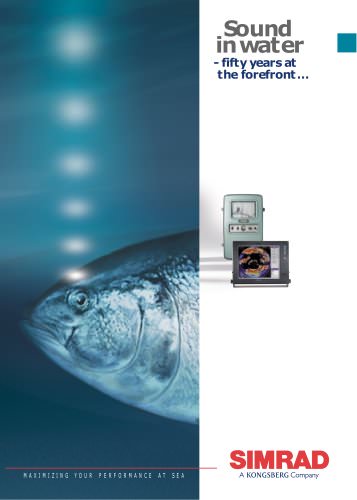
Catalog excerpts
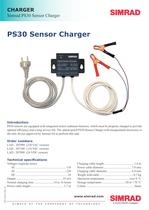
Simrad PS30 Sensor Charger Normal charge 14-16 hours Caution: Follow directions (or PS30 sensors are equipped with integrated nickel cadmium batteries, which must be properly charged to provide optimal efficiency and a long service life. The splash-proof PS30 Sensor Charger with encapsulated electronics is the only device approved by Simrad AS to perform this task. Order numbers Technical specifications Voltages (separate units): ALWAYS AT THE FOREFRONT OF TECHNOLOGY
Open the catalog to page 1
Bottom, front and side views of charger Mounting bracket dimensions WARNING! The improper charging of sensors can result in an explosion with the potential for severe material damage and/or personal injury. Simrad assumes no liability for the use of non-specified charging components or procedures. Observe the applicable instructions concerning safety and charging. ALWAYS AT THE FOREFRONT OF TECHNOLOGY
Open the catalog to page 2
CATCH MONITORING Accurate distance to the bottom! With a built-in echo sounder, this new PI sensor is full of advanced technology. Wherever you place it, it will always tell you the exact MAXIMIZING YOUR PERFORMANCE AT SEA A KONGSBERG Company
Open the catalog to page 3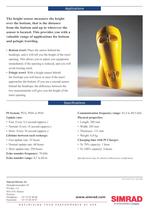
The height sensor measures the height over the bottom, that is the distance from the bottom and up to wherever the sensor is located. This provides you with a valuable range of applications for bottom • Bottom trawl: Place the sensor behind the headrope, and it will tell you the height of the trawl opening. This allows you to adjust you equipment immediately if the opening is reduced, and you will avoid loosing catch. • Pelagic trawl: With a height sensor behind the footrope you will know at once if the trawl approaches the bottom. If you use a second sensor behind the headrope, the...
Open the catalog to page 4
CATCH MONITORING PI Bottom Contact sensor With patented technology and awardwinning design, Simrad provides you full control of the actions that take place at the bottom. Mounted on a bottom trawl, pelagic trawl or purse seine, this sensor will provide the important information when you need The Bottom Contact sensor mounted on a bottom trawl will let you On a purse seine you will be On a pleqgic trawl, the sensor know once the trawl lifts a few centimeters above the bottom. You notified once the seine reaches will notify you once you get can then immediatley perform the necessary...
Open the catalog to page 5
The Bottom Contact sensor will let you know immediately if your gear touches • Bottow trawl: If your trawl lifts off the bottom, this may cause fish to escape, and hence reduce the catch. This sensor will detect this, and allow you to trim your equipment for perfect balance. • Pelagic trawl: On a pelagic trawl, this sensor proves very useful when the trawl moves downwards. It will let you know immediately if the footrope touches bottom. • Purse seine: When you work with a purse seine, you need to know when the seine reaches the bottom. This sensor will let you know, once it • Danish seine:...
Open the catalog to page 6
CATCH MONITORING When is the trawl full? trawl. Save time and fuel, haul in the trawl MAXIMIZING YOUR PERFORMANCE AT SEA
Open the catalog to page 7
Some professionals claim that the Catch sensor is the most important sensor on the trawl. Why? Because it will tell you the amount of catch in the trawl. The sensor simply monitors the expansion of the meshes in the cod-end. Once the volume caught is enough to expand the meshes, they will pull the detector wires and engage the sensor. The sensitivity of the sensor can easily be adjusted, just extend the detection rubber bands to span additional meshes. To monitor the filling rate, we recommend that you use minimum two sensors. Place the first sensor at the far end of the cod-end, it will...
Open the catalog to page 8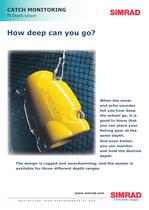
CATCH MONITORING good to know that same depth. The design is rugged and awardwinning, and the sensor is available for three different depth ranges. MAXIMIZING YOUR PERFORMANCE AT SEA
Open the catalog to page 9
The PI Depth sensor provides information about the current depth and the depth changes of your gear. • Bottom trawl: On a bottom trawl, you will use the sensor to achieve full control when shooting, and to position the trawl on the slope. • Pelagic trawl: During pelagic trawling, you know how important it is to position the trawl relative to the largest concentration of fish. By using a Depth sensor, you can monitor the exact depth relative to the surface, and adjust the trawl depth accordingly. Additional depth sensors on the doors will monitor if the doors stay at the same depth. • Purse...
Open the catalog to page 10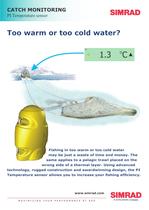
CATCH MONITORING PI Temperature sensor Too warm or too cold water? T2 1.3 C Fishing in too warm or too cold water may be just a waste of time and money. The same applies to a pelagic trawl placed on the wrong side of a thermal layer. Using advanced technology, rugged construction and awardwinning design, the PI Temperature sensor allows you to increase your shing efciency. www.simrad.com MAXIMIZING YOUR PERFORMANCE AT SEA
Open the catalog to page 11
The PI Temperature sensor tells you the exact sea water temperature while you are The water temperature is an important parameter. Fish and bait are temperature sensitive, and they are normally found within specific temperature zones for However, the temperature layers in the water are changing constantly, and for this reason the temperature must be monitored constantly. Fishing in an area with unfavourable water temperature might be just a waste of time! For any kind of trawling, use this sensor to monitoring and log the temperature. Then, increase your knowledge about the correlation...
Open the catalog to page 12
CATCH MONITORING PI Spread and Remote sensors Check the trawl doors! This dynamic duo tells you the exact distance between the trawl doors. Used on bottom and pelagic trawls the Spread and Remote sensors provide crucial information about your trawl behaviour. On a twin trawl, simply add a Remote sensor and you have both openings covered! MAXIMIZING YOUR PERFORMANCE AT SEA A KONGSBERG Company
Open the catalog to page 13
These two sensors always work in pairs. They are used to monitor the physical distance between the trawl doors during bottom and pelagic trawling. Use a Spread sensor on the port door and a Remote sensor on the starboard door. Both sensors are normally mounted in special adapters, but you may also attached them to the wing-end or warp using snap hooks or rope. The Spread sensor communicates with the Remote sensor using a special transverse communication link. By means of this link it measures the excact distance (maximum 350 meters) between the two sensors. The information is is transmitted...
Open the catalog to page 14All Simrad catalogs and brochures
-
General Catalog
84 Pages
-
Single beam systems
12 Pages
-
Catch Monitoring Systems
16 Pages
-
Sonars
12 Pages
-
Multibeam systems
12 Pages
-
Product catalogue
84 Pages
-
Echosounders
8 Pages
-
Simrad main product catalogue
43 Pages
-
Simrad scientific systems
8 Pages
-
Simrad SH90
4 Pages
-
ES200-7C
2 Pages
-
ES70-18CD
4 Pages
-
Software release note
2 Pages
Archived catalogs
-
SIMRAD CATALOGUE
36 Pages
-
FS70 Trawl Sonar
2 Pages
-
SIMRAD Catlogue
36 Pages
-
Sonar brochures
22 Pages
-
Echo sounder brochures
36 Pages

















